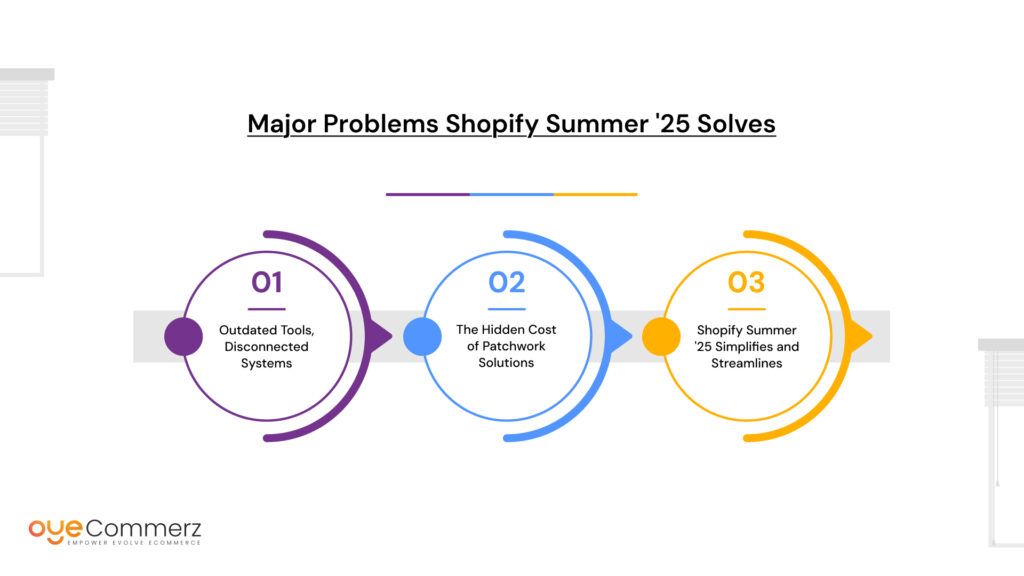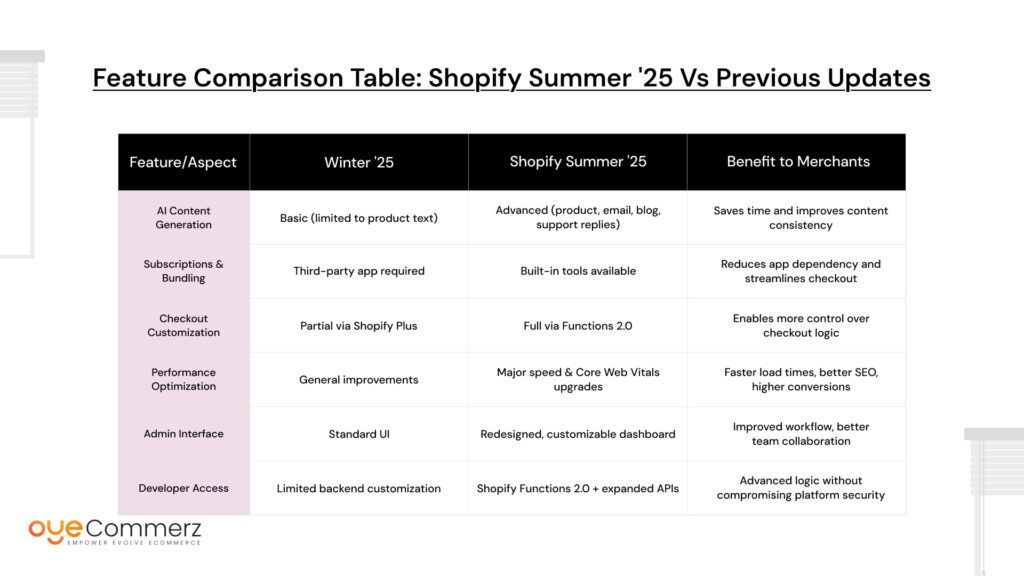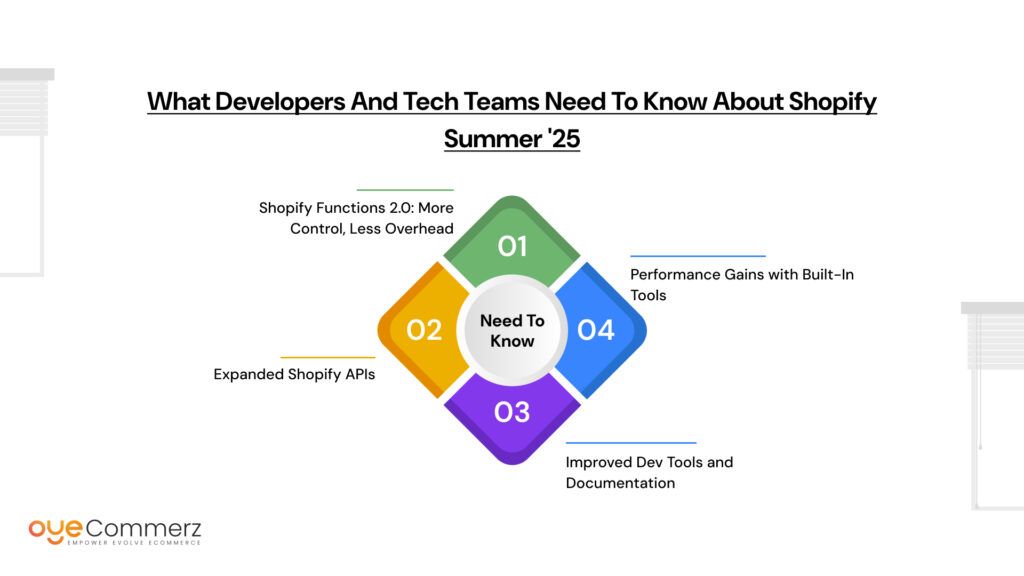Over 2 million merchants worldwide rely on Shopify and in the U.S. alone, Shopify powers more than 25% of e-commerce stores. With Shopify Summer ’25 now live, staying informed isn’t just helpful—it’s essential.
Shopify evolves fast, and if you’re not tracking the latest feature updates, you risk falling behind competitors who are.
Each new release impacts performance, customer experience, and sales potential. Miss an update, and your store could be operating with outdated tools, costing you conversions and revenue.
This guide breaks down Shopify Summer ’25 in clear, actionable terms—whether you’re new to e-commerce, planning a migration, or optimizing your existing Shopify store. From AI-powered tools to native subscriptions and speed upgrades, here’s everything you need to know to stay competitive in 2025.
Table of Contents
ToggleWhat is Shopify Summer?
Shopify Summer is part of Shopify’s bi-annual product release cycle, bringing fresh innovations and critical updates designed to help merchants stay ahead in the fast-moving world of e-commerce. Released every mid-year, Shopify Summer introduces both merchant-facing features and developer tools aimed at enhancing store performance, customer experience, and operational efficiency.
The Shopify Summer ’25 release is one of the most significant to date, reflecting Shopify’s continued investment in AI, native functionality, and speed-first architecture. Unlike smaller iterative updates, this seasonal rollout is structured to deliver strategic improvements that merchants can act on immediately—especially ahead of the Q3/Q4 shopping surge.
Whether you’re a seasoned merchant or new to Shopify, understanding what’s packed into the Summer release helps ensure you’re not missing out on performance gains or new revenue opportunities.
In this breakdown, we’ll walk you through everything you need to know—from beginner-friendly features to advanced backend upgrades—so you can make smarter decisions for your business in 2025 and beyond.
For Beginners: What is Shopify and Why Merchants Love It
If you’re new to e-commerce or exploring the idea of launching your own online store, Shopify is one of the most beginner-friendly platforms available today. It allows anyone—from solo entrepreneurs to growing brands—to build, launch, and manage a professional online store without needing to write code.
So, what makes Shopify stand out?
It’s an all-in-one e-commerce solution designed to simplify everything from inventory management and payment processing to shipping and marketing. It’s also highly scalable, which means your store can grow with your business whether you’re selling ten products or ten thousand.
Why Shopify is a Top Choice for US-Based Merchants
- Fast and secure: Shopify hosts your store on its own servers, ensuring fast load times and PCI-compliant security.
- 24/7 support: Round-the-clock assistance helps merchants resolve issues quickly.
- Built-in marketing tools: From SEO to email marketing, Shopify has tools that help attract and convert customers.
- Extensive app ecosystem: Access thousands of apps to add custom features to your store.
Why Shopify Summer Matters for New Merchants
With every major seasonal release like Shopify Summer, the platform introduces new features that make it even easier for first-time sellers to launch and scale. The Summer ’25 update includes enhancements like built-in subscription tools, improved AI automation, and a more intuitive admin dashboard—making Shopify even more powerful for beginners.
If you’re just starting your e-commerce journey, there’s never been a better time to jump in. The features launched in Shopify Summer ’25 are designed to lower barriers, speed up setup, and increase your chances of early success.
Major Problems Shopify Summer '25 Solves

Running an e-commerce business today isn’t just about selling products it’s about delivering a seamless, fast, and personalized customer experience. But many merchants still face persistent challenges that slow growth and hurt performance.
Outdated Tools, Disconnected Systems
Many merchants rely on third-party apps to fill feature gaps—subscriptions, product bundles, and customer communication tools. These add-ons can create a bloated tech stack, slow down your store, and introduce security and compatibility issues.
The Hidden Cost of Patchwork Solutions
Using disconnected tools not only drains your budget but also complicates store management. You may be juggling multiple logins, dealing with inconsistent data, or patching bugs caused by app conflicts. Worse, poor performance and longer load times can directly impact your search rankings and conversion rates.
Shopify Summer ’25 Simplifies and Streamlines
The Shopify Summer release is designed to solve these issues by introducing native features that reduce dependence on third-party apps. From built-in subscriptions to AI-powered content creation and significant performance upgrades, this update helps merchants streamline operations, reduce costs, and improve customer experience—all within Shopify’s ecosystem.
With a more unified backend, faster page speeds, and smarter automation, Shopify Summer ’25 gives merchants the tools they need to stay competitive and scalable in 2025.
Headline Features in Shopify Summer '25

The Shopify Summer ’25 release brings a wave of powerful features aimed at simplifying operations, improving performance, and helping merchants grow smarter and faster. Whether you run a small business or manage a large-scale operation, these updates are designed to boost efficiency and profitability.
Here’s a breakdown of the most important feature rollouts:
1. Shopify Magic AI 2.0
Shopify’s AI suite just got a major upgrade. Magic AI 2.0 includes smarter content generation for product descriptions, email replies, blog posts, and more. It also offers personalized product recommendations, automated SEO tags, and chatbot enhancements—all built directly into the admin interface.
Why it matters: Merchants can save hours on content creation and marketing tasks, while also delivering a more tailored customer experience.
2. Native Subscription and Bundling Tools
Shopify Summer ’25 introduces built-in functionality for subscriptions and product bundles—no third-party apps required. Whether you’re selling monthly boxes or grouping products for volume discounts, this update gives you full control over how products are packaged and sold.
Why it matters: Lower app costs, seamless checkout, and easier management of recurring revenue.
3. Enhanced Performance and Speed Upgrades
Shopify has optimized page speed, reduced render-blocking scripts, and improved image handling. This is part of their ongoing focus on Core Web Vitals, a critical factor in SEO and user experience.
Why it matters: Faster sites rank better on Google and convert more visitors into buyers.
4. Shopify Functions 2.0
For developers and advanced users, Functions 2.0 expands custom logic in checkout, discounts, and shipping calculations. You can now write and deploy backend code without touching Shopify’s core infrastructure.
Why it matters: Greater flexibility for building tailored customer journeys and dynamic pricing rules.
5. Unified Admin Dashboard
The redesigned admin dashboard is cleaner, faster, and easier to navigate. It includes customizable widgets, better mobile support, and more granular permissions for team members.
Why it matters: Smoother workflows, improved productivity, and faster decision-making.
The Shopify Summer updates reflect a clear message: fewer external tools, more native power. With these features, merchants can focus less on managing technology and more on growing their business.
Feature Comparison Table: Shopify Summer '25 vs Previous Updates

One of the best ways to understand the impact of Shopify Summer ’25 is by comparing it directly to previous updates. While Shopify has consistently released new tools over the years, this summer’s release marks a shift toward deeper native integration, smarter automation, and speed optimization.
Below is a comparison table that outlines the most notable improvements from Winter ’25 to Summer ’25:
Why This Comparison Matters
If you’re currently running an older version of Shopify or using a third-party e-commerce platform, these updates highlight just how far the platform has evolved. Shopify Summer is not just a seasonal refresh—it’s a leap forward in how e-commerce can be managed efficiently and at scale.
Whether you’re considering a switch or looking to optimize your existing store, understanding these differences can help you make smarter, more future-proof decisions.
What Developers and Tech Teams Need to Know About Shopify Summer '25

While many updates in Shopify Summer ’25 cater to merchants and store owners, this release also delivers powerful new tools for developers, IT teams, and technical leads who manage store architecture and integrations.
Here’s what matters most on the technical side:
1. Shopify Functions 2.0: More Control, Less Overhead
Developers can now create deeper logic within key areas like shipping, checkout, and discounts using Shopify Functions 2.0. These run on Shopify’s infrastructure, so they’re fast, secure, and scalable—without requiring custom apps or external servers.
Use case: Create dynamic shipping rates, tiered discount rules, or advanced customer segmentation directly in your store logic.
2. Expanded Shopify APIs
Shopify has expanded its API coverage, particularly in areas like product bundles, metafields, and admin customization. These APIs now provide more granular data access and improved webhook reliability—making it easier to build robust integrations with ERPs, CRMs, and third-party tools.
3. Improved Dev Tools and Documentation
Shopify CLI updates now support Functions 2.0, making it easier to test and deploy changes in local environments. The documentation for theme development, Liquid, and storefront APIs has also been revamped for clarity and ease of use.
4. Performance Gains with Built-In Tools
Shopify has significantly improved Core Web Vitals by optimizing theme rendering, lazy loading assets, and reducing render-blocking scripts. These improvements reduce the need for custom performance hacks or workarounds.
Why It Matters for Technical Teams
The Shopify Summer update moves Shopify closer to being a fully extensible platform without compromising speed or reliability. For in-house dev teams and tech partners, this means fewer limitations, less reliance on apps, and faster time-to-deployment for custom features.
Whether you’re building a custom checkout flow or managing multi-store operations, Shopify Summer ’25 gives your team more power and precision—natively and securely.
Migrating to Shopify in 2025? Here’s Why Now is the Best Time
Outdated Platforms Are Holding You Back
If you’re still operating on platforms like Magento, WooCommerce, or Squarespace, you may be dealing with slow performance, security issues, limited customization, or costly third-party integrations. These platforms often require constant maintenance and developer support just to stay functional.
Every Delay Hurts Growth
Outdated infrastructure can cause more than just technical headaches—it can cost you customers. Slower site speeds, lack of mobile optimization, and complex checkouts contribute to higher bounce rates and abandoned carts. You also miss out on key features like native subscriptions, AI-driven content creation, and fast-loading storefronts—all of which are now built directly into Shopify.
Shopify Summer Makes Now the Ideal Time to Migrate
The Shopify Summer ’25 release makes migrating smarter, not harder. With built-in tools that replace many third-party apps, enhanced site performance, and expanded customization through Shopify Functions 2.0, you gain more control with less hassle. Shopify is built to support you at every stage of growth—from startup to scale-up.
If you’ve been thinking about moving your store, now is the time to act.
Why Migrate with Oyecommerz?
At Oyecommerz, we specialize in seamless Shopify migrations for US-based businesses. Whether you’re on Magento, Squarespace, WooCommerce, or a custom solution, our team handles the process end-to-end.
Here’s what you can expect with Oyecommerz:
- Zero data loss and minimal downtime
- Customized Shopify store setup and theme development
- Product, customer, and order migration with 100% accuracy
- Post-launch support and performance optimization
- Deep expertise in Shopify’s latest tools, including Shopify Summer features
Don’t let outdated systems limit your growth. Let Oyecommerz help you unlock the full potential of your business with Shopify’s most powerful update yet.
Contact to Migrate your Site to Shopify Now
Conclusion
The Shopify Summer ’25 release is more than just a routine update—it’s a strategic leap forward for merchants, developers, and anyone serious about building a scalable e-commerce business.
From AI-powered tools and built-in subscriptions to backend flexibility and speed enhancements, this release empowers you to run smarter, faster, and leaner. Whether you’re launching your first online store or managing a multi-channel brand, Shopify Summer makes it easier to compete, convert, and grow.
If you’re still on another platform or struggling with outdated systems, now is the perfect time to migrate. And if you’re already on Shopify, this is your opportunity to fully leverage the new capabilities packed into Summer ’25.
Stay updated. Act early. And take full advantage of what Shopify Summer has to offer.
Need help migrating or optimizing your Shopify store? Partner with trusted experts like Oyecommerz to ensure you get it right from the start.
Frequently Asked Questions
Shopify offers a comprehensive suite of features for e-commerce businesses, including:
User-Friendly Store Builder: Drag-and-drop editor with customizable themes.
Product Management: Add, organize, and track inventory with ease.
Payment Integration: Built-in Shopify Payments and support for 100+ payment gateways.
Mobile Responsiveness: Fully responsive design for optimal mobile shopping experience.
SEO and Marketing Tools: Built-in SEO, discounts, gift cards, email marketing, and more.
App Store: Thousands of apps for extending functionality.
Shipping & Tax Management: Real-time shipping rates, tax calculations, and fulfillment support.
Analytics & Reporting: Dashboard with sales reports, customer insights, and performance metrics.
Multi-Channel Selling: Sell on Amazon, eBay, Instagram, Facebook, and more.
24/7 Customer Support: Live chat, email, and phone support available at all times.
Shopify’s mission is:
“To make commerce better for everyone.”
This means empowering entrepreneurs and businesses of all sizes with tools to start, grow, market, and manage their businesses across various channels.
Top tools in 2025 include TradeGecko (QuickBooks Commerce), Skubana, Stocky (by Shopify), Zoho Inventory, and Cin7, all offering seamless automation, multi-channel syncing, and advanced analytics.
The core basics of using Shopify include:
Creating an account: Start with a free trial, then select a plan.
Choosing a theme: Pick a design template from free or premium options.
Adding products: Include product descriptions, pricing, images, and inventory.
Setting up payments: Choose payment gateways like Shopify Payments, PayPal, or others.
Configuring shipping: Set shipping zones, rates, and providers.
Launching the store: Make your site live and start selling.
Shopify stands out due to its ease of use, scalability, and robust ecosystem. Unlike open-source platforms like WooCommerce or Magento, Shopify is fully hosted, meaning users don’t need to worry about web hosting or security updates. Additionally, Shopify’s App Store, POS system, and strong multi-channel capabilities make it suitable for both beginners and enterprise-level businesses.




